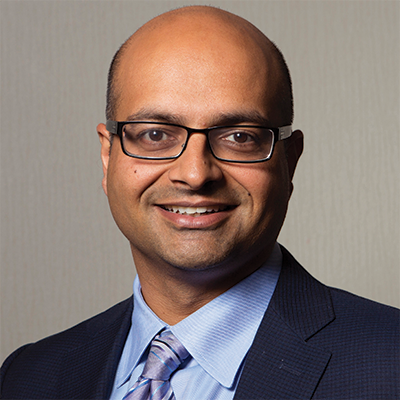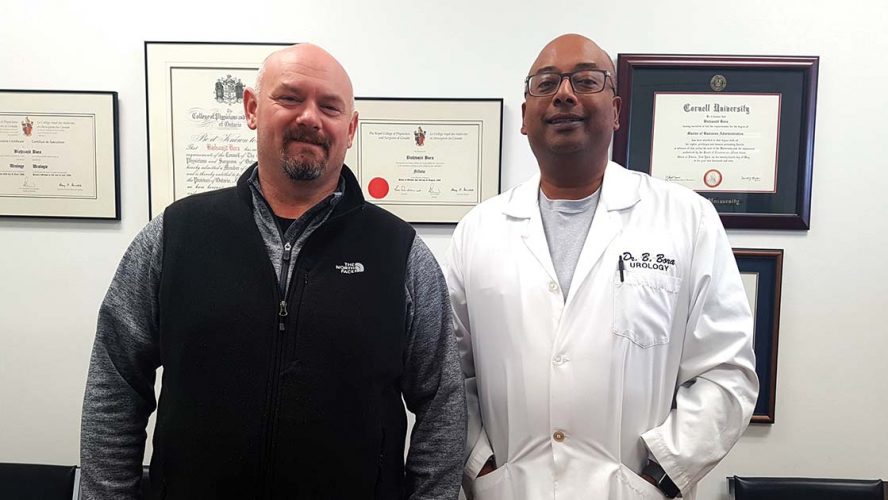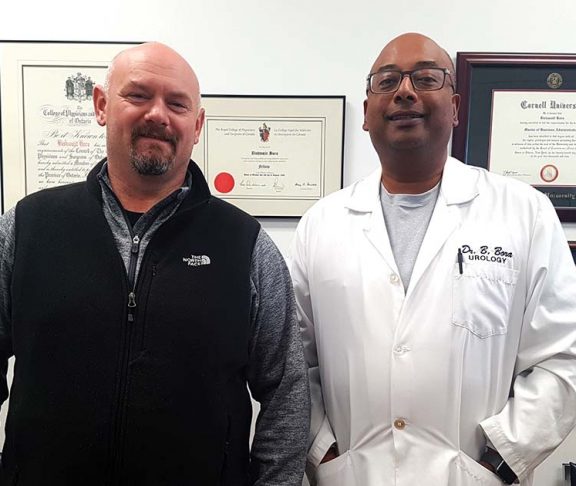
Dr. Girish Kulkarni, PhD, FRCSC
Associate Professor of Urology, Division of Urology, Departments of Surgery & Surgical Oncology at Princess Margaret Cancer
Ryan Lougheed noticed blood in his urine and immediately knew something wasn’t right. When the 42-year-old from Sudbury, ON learned he had bladder cancer in November 2017 he became one of the 9,000 Canadians who are diagnosed with the disease each year.
Lougheed admits that he hadn’t heard of bladder cancer prior to receiving the news, but soon discovered it was the fifth most common cancer in Canada. “I was devastated to hear that I had the disease,” he says. Once he caught his breath, he started digging for information. “Knowledge was important to me. I wanted to understand what the treatment was and whether I could be cured.”
A friend told him about a magazine story discussing a new technology called blue light cystoscopy (BLC). It became available in Canada in 2015 but was not widely used. Lougheed was keen to find out more.
It’s important to advocate for yourself. Patients have the time and the motivation of their own health to do that.
Ryan Lougheed, bladder cancer patient
New hope for cancer patients
BLC uses a diagnostic agent that is absorbed by fast-growing cancer cells. The blue light makes tumours glow bright pink, allowing doctors to see them clearly and remove them. Bladder cancer has a high recurrence rate (60%–70%) resulting in patients needing regular examinations of their bladder followed by surgery to remove any recurring tumours. These frequent procedures and surgery make it the most expensive cancer to treat.
Lougheed spoke with his urologist about BLC. Their discussion sparked the creation of the Bladder Cancer Tech fund, a fundraising initiative created to make BLC and other leading technologies available to area patients. In just six months, Lougheed helped to raise $70,000 toward purchasing the necessary equipment.
“It’s important to advocate for yourself. Patients have the time and the motivation of their own health to do that,” he notes. “I had no idea where that initial conversation with my doctor was going to go, but I was determined to find out how we could get BLC for my local hospital, Health Sciences North [Sudbury, ON].”
Patients advocating for their health is important so other Canadians can learn about all the options available to them.
Dr. Girish Kulkarni, urologist
A new standard of care
Dr. Girish Kulkarni, a urologist at Toronto’s Princess Margaret Cancer Centre, recognizes the need for BLC to be available. He has been using the technology for more than a year and found that it has been effective for decreasing recurrence rates. “It has had a significant benefit for patients,” he notes. “There’s a lot of potential for this technology.”
The key factor holding some hospitals back from adopting BLC is the initial cost, but Dr. Kulkarni explains that although the initial investment may be high, the long-term savings are worth it. “We have studied BLC from the Canadian perspective and the technology can minimize the costs of future bladder cancer care,” he says. He recognizes that this lack of awareness is one of the obstacles behind why more hospitals aren’t using BLC. “Patients advocating for their health is important so other Canadians can learn about all the options available to them,” he says. “As physicians are exposed to this knowledge, it can make them advocates, too.”
Dr. Kulkarni is hopeful for the future of bladder cancer treatment and care. “BLC was necessary in order for us to get to the next step in medicine,” he says. “The way I envision it, this technology will be the new standard of care for most bladder cancer resections.”
Become an advocate for access to BLC technology.
Speak with your urologist, hospital administrator, or elected politician; or visit Detect Bladder Cancer to find out how you can get involved.


